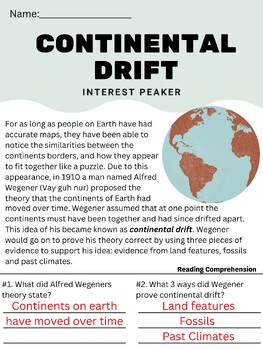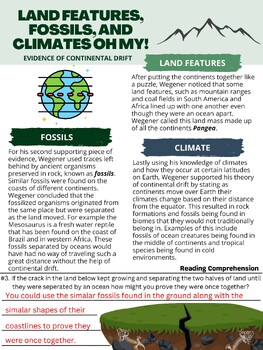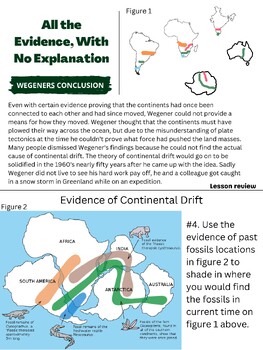Continental Drift Interactive Worksheet
Stemper Fi
0 Followers
Grade Levels
5th - 8th
Subjects
Resource Type
Standards
NGSSMS-ESS2-3
NGSSMS-ESS2-2
Formats Included
- Zip
Pages
8 pages
Stemper Fi
0 Followers
Description
Introduce continental drift to your students with this interactive reading worksheet over Alfred Wegener and how he proved continental drift using evidence from fossils, past climates and land forms. Students will read a passage and fill out key concept questions as they move along four pages ending the reading with a check for understanding page with six questions that all emphasize key concepts.
Total Pages
8 pages
Answer Key
Included
Teaching Duration
30 minutes
Report this resource to TPT
Reported resources will be reviewed by our team. Report this resource to let us know if this resource violates TPT’s content guidelines.
Standards
to see state-specific standards (only available in the US).
NGSSMS-ESS2-3
Analyze and interpret data on the distribution of fossils and rocks, continental shapes, and seafloor structures to provide evidence of the past plate motions. Examples of data include similarities of rock and fossil types on different continents, the shapes of the continents (including continental shelves), and the locations of ocean structures (such as ridges, fracture zones, and trenches). Paleomagnetic anomalies in oceanic and continental crust are not assessed.
NGSSMS-ESS2-2
Construct an explanation based on evidence for how geoscience processes have changed Earth’s surface at varying time and spatial scales. Emphasis is on how processes change Earth’s surface at time and spatial scales that can be large (such as slow plate motions or the uplift of large mountain ranges) or small (such as rapid landslides or microscopic geochemical reactions), and how many geoscience processes (such as earthquakes, volcanoes, and meteor impacts) usually behave gradually but are punctuated by catastrophic events. Examples of geoscience processes include surface weathering and deposition by the movements of water, ice, and wind. Emphasis is on geoscience processes that shape local geographic features, where appropriate.





